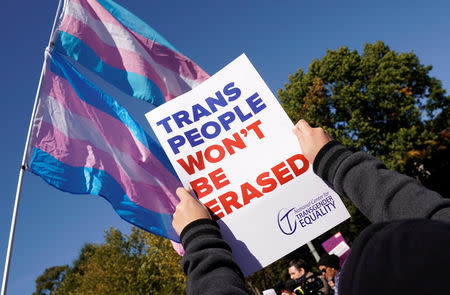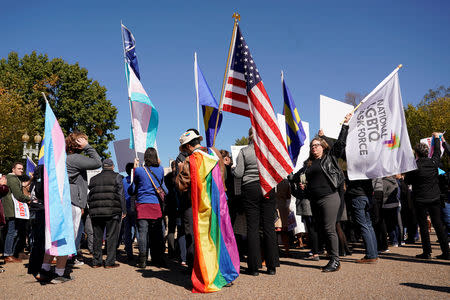The Trump administration could erase civil rights for 1.4 million trans Americans. Here's how.

According to a recent New York Times report, the U.S. Department of Health and Human Services has circulated a memo that proposes all Title IX regulations “define sex as either male or female, unchangeable, and determined by the genitals that a person is born with.”
In other words, there could be sweeping changes that could unravel the civil rights of 1.4 million Americans who identify as transgender or gender nonconforming, which does not fall in the rigid definition of sex as laid out by the Trump administration.
“This is an attack on the very lives and existence of transgender people,” James Esseks, director of the ACLU LGBT & HIV Project said in a statement. “It is painful, it is hateful, and it will not go unchallenged. Transgender people are real and transgender lives have meaning.”
“People often try to reduce fights over the rights of transgender people to debate over which bathrooms people can use,” says civil rights attorney Roberta Kaplan, who was behind the landmark case that shut down the Defense of Marriage Act and secured the rights for same-sex couples to get married in America.
“But the reality is that a move like this goes way beyond bathrooms,” says Kaplan. “With respect to Title IX, it would have very real and damaging effects, as transgender students of all ages — young children in elementary school and junior high, in addition to college students — would lose the critical protection of federal laws against what is often unendurable bullying and harassment on the basis of their gender identity.”
But how does Title IX, which is often closely associated with collegiate sports, extend to issues such as transgender rights and even protect sexual assault survivors? Here’s a breakdown on the evolution of the anti-discrimination law and how it grew to become a benchmark in establishing civil rights for women and the LGBTQ community.
What is Title IX?

Under Title IX of the Education Amendments Act of 1972, “no person in the United States shall, on the basis of sex, be excluded from participation in, be denied the benefits of, or be subjected to discrimination under any education program or activity receiving Federal financial assistance.”
The federal civil rights law covers students and faculty of all educational institutions and programs that benefit from federal funding, which includes nearly all U.S. schools in addition to museums and libraries. So in effect, Title IX made educational organizations accountable for how women were treated on their campuses. It states “No equal opportunities for women, no money.”
The need for Title IX was born out of a “major gap in gender discrimination” that was not addressed in Title VI which prohibits schools from discrimination on the basis of race, according to Seguin Strohmeier, an associate attorney at Kaplan Hecker & Fink who focuses on Title IX cases.
At the time it was enacted, Title IX was widely cited in the overhaul of athletic programs with regulations mandating that the same opportunities — and the same budgets — be given to women and girls in all sports. For the first time, schools and universities couldn’t prevent women from starting all-girls teams, and they had to provide the same resources they gave to boys and men on and off the field.
“From an athlete’s perspective, we knew we’d get athletic scholarships for the first time if it was passed. But I knew it was about education” for all, tennis legend Billie Jean King told MAKERS.
Title IX and sexual assault

Over the years, Title IX expanded to include protections for sexual assault survivors because “through a number of Supreme Court cases and other court cases, it has been established that sexual assault itself is a form of gender discrimination,” explains Strohmeier.
Under Title IX, educational institutions are required to respond to allegations of assault — an issue that disproportionately affects women — either between students or between teachers and students in a way that doesn’t amount to “deliberate indifference.”
“In other words, schools have to respond in a way that isn’t completely unreasonable,” says Strohmeier. “It puts the onus on schools to address issues that come to their attention.”
Title IX and transgender rights

In 1990, the Supreme Court ruled that workplace discrimination on the basis of “sex stereotyping” is unconstitutional after a consultant named Ann Hopkins sued Price Waterhouse for gender discrimination after she was denied partnership in the firm for being “macho” and “aggressive.”
With this ruling, Strohmeier explains, it was established that denying employment or benefits to an individual, namely a woman, who doesn’t “conform to what is properly female” is a form of gender discrimination. For the trans community, this meant that they should be allowed to bring their full selves to work without being punished for how they identify or express themselves.
Using this ruling as precedent, trans rights advocates were able to argue that there is a broader, nonbinary definition of sex that can be applied to Title IX which in turn would extend its protections to the trans community.
“It’s not just what your biological sex is, it’s how you present and how you demonstrate your sex that is protected,” says Strohmeier.
In May 2016, the Obama administration left no room for doubt when it released its unprecedented “Dear Colleague” letter, which stated that Title IX “does not leave students without protections from discrimination, bullying, or harassment. All schools must ensure that all students, including LGBT students, are able to learn and thrive in a safe environment.”
The most well-known trans protections granted by Title IX are transgender students’ access to bathrooms, locker rooms, and other gender-segregated spaces of their choice.
On President Trump’s first day in office in 2017, his administration rescinded Obama’s “Dear Colleague” letter, leaving it up to individual schools on how to “treat a student’s gender identity as the student’s sex for purposes of Title IX and its implementing regulations.” The president has since deleted the LGBTQ rights page from the White House website, tweeted his support of removing transgender people from the U.S. armed forces, and erased LGBTQ categories from the 2020 census.
“I wish that we could say that we were surprised, but unfortunately, we’re not,” says Zeke Stokes, the vice president of programming at GLAAD.
“The consequences are in a lot of ways so far-reaching that they’re incalculable in terms of how many people could be impacted by this,” Stokes continues. “This is not only one of the most drastic moves against trans people from this administration — but one of the most sinister.”
Redefining gender under Title IX

So what exactly does this mean? “From the point of view of a lawyer, this is an attempt to take a nation’s entire anti-discrimination law and change an underlying definition that would change the protections of a certain group of people because of their gender identity,” says Strohmeier. “It seems incredibly broad and could potentially touch every aspect of trans people’s lives and their rights. It’s reducing the way transgender people are protected in their humanity and in their personhood”
Many in the legal and advocacy spheres consider these efforts the most severe attack on transgender rights in America by the current administration thus far, but the lasting effects could prove even more severe.
“I think there’s certainly a lot of fear in the community,” says trans activist Sarah McBride, who serves as the national press secretary for the Human Rights Campaign. “It’s about being able to be affirmed an identity. It’s about being able to be safe from harassment or even violence. It’s about being able to exist in public life in any way — being able to go to school, to be able to find a job.”
“If this proposal were to be implemented, it would embolden hate, prejudice, and discrimination throughout our country. We know that while hate and prejudice targeting of the transgender community has always existed, it’s been inflamed and emboldened by politicians who are all too eager to appeal to the darkest undercurrents of our society,” McBride adds.
What now?
In the wake of the news, thousands expressed their support of the trans community on social media with the hashtag #WontBeErased, and LGBTQ activists have refused to remain silent.
“I think there’s certainly a lot of fear in the community,” says McBride. “But there’s a determination to fight back, to share stories, and to make clear that transgender people won’t be erased — that we are part of the beautiful, diverse view of this country and that we’re here to stay.”
They can try all they want, but they cannot erase us.
— Janet Mock (@janetmock) October 21, 2018
Meet my daughter, Ellie. She is vibrant, artistic and loves a pun. We stand with her and her trans family, especially those most marginalized already by our racist & transphobic systems. #WeWontBeErased #TransIsBeautiful pic.twitter.com/Tzo0Y02oxL
— Vanessa Ford (@VanessaFordDC) October 21, 2018
LGBTQ advocacy groups GLAAD, Human Rights Campaign, and the National Center for Transgender Equality quickly came together Sunday to stand in solidarity of trans rights with a petition in opposition to the proposal from the Trump administration. Advocacy groups also have one clear message for trans allies: Vote on Nov. 6.
“Right now we are very close to one of the most critical elections of our lifetime,” says McBride. “And so we’re organizing and mobilizing the roughly 10 million LGBTQ voters across this country and the tens of millions more who are allies to understand that when politicians come for the LGBTQ community, we need to come for them on election day.”
According to a terrifying leaked memo obtained by the @nytimes, the Trump administration is seeking to redefine federal civil rights law (Title IX) to exclude protections for transgender people. We’re fighting back! Want to help? https://t.co/PtCYJd6w6B
— GLAAD (@glaad) October 22, 2018
Aside from encouraging people to turn out for pro-equality candidates up and down the ballot, McBride wants young transgender people to know that there is hope in the army of advocates for equality.
“I think that every transgender young person should know that there are advocates and activists and allies across this country who see them, who love them, and who are fighting every single day to make sure they are treated with the dignity and fairness that we all deserve,” says McBride. “And as scary and as frightening as this moment in our politics might be, that isn’t changing and that will never change.”
